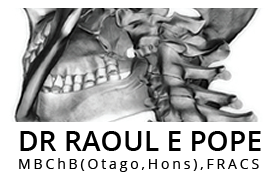Mechanical Causes: Spondylosis
Spondylosis (spinal osteoarthritis) is a degenerative disorder that may cause loss of normal spinal structure and function. Although aging is the primary cause, the location and rate of degeneration is individual. The degenerative process of spondylosis may affect the cervical (neck), thoracic (mid-back), or lumbar (low back) regions of the spine.
Spondylosis often affects the following spinal elements:
Intervertebral Discs
As people age, certain biochemical changes occur affecting tissue found throughout the body. In the spine, the structure of the intervertebral discs (annulus fibrosus, lamellae, nucleus pulposus) may be compromised. The annulus fibrosus (eg, tire-like) is composed of 60 or more concentric bands of collagen fiber termed lamellae. The nucleus pulposus is a gel-like substance inside the intervertebral disc encased by the annulus fibrosus. Collagen fibers form the nucleus along with water and proteoglycans. The degenerative effects of aging can weaken the annulus fibrosus' structure, causing the 'tire tread' to wear or tear. The water content of the nucleus decreases with age affecting its ability to rebound following compression (e.g. shock absorbing quality). The structural alterations from degeneration may decrease disc height and increase the risk for disc herniation.
There are numerous mechanical causes of back pain including:
Spondylosis : (Osteo-Arthritis) : Spinal disease, associated with degenerative discs.
Facet Joints (or Zygapophyseal Joints) : Each vertebral body has four facet joints.
Bones and Ligaments Osteophytes : Bone spurs affecting blood supply to the vertebra.
Spondylosis Symptoms : Spondylosis may affect cervical (neck) or lower (lumbar) spine.
Spondylolisthesis : Spondylolysis with a forward translation of the vertebra.
Back Strain or Back Sprain : Pulled back muscles, caused by overloading or overuse.
Sciatica: Travelling back, buttock & leg pain, tingling, numbness or weakness.
Spinal Stenosis : Narrowing of the spinal canal, causing pressure on the spinal cord.
Herniated Discs : Slipped discs occur when a spinal disc splits or ruptures.

